Welcome to the fun and adventure of houseboating!
If you’re new to boating and everything that goes into planning a houseboat trip, then you’ve come to the right place. Houseboating 101 provides a solid introduction to the safe operation of a houseboat, some good tips on planning your first houseboat trip, and tricks to make the job of navigating both the marina and lake easy and fun.
What is a houseboat exactly?
Well, it’s actually what you might think it is: A luxury boat that provides all of the amenities from home while you enjoy a getaway on the lake. Our modern houseboats are designed to be fuel efficient, have minimal impact on the environment, and offer comforts only dreamed about a few years ago. Most Forever Houseboats are designed and built in our company-owned factory and each one is tailored to the waterways on which they serve.
Houseboating is a unique vacation choice...
and many devotees enjoy the experience as “comfortable camping on the beach.” Houseboat rentals provide the unique opportunity to travel with a larger group with less hassle and at a lower total cost than a typical vacation. When you compare the cost and planning time required to make travel arrangements, meal planning as well as entertainment plans for a group of 10, 12 or more – houseboating is not only more relaxed and unique, it can cost substantially less than most vacations.
How to Anchor Your Antelope Point Houseboat
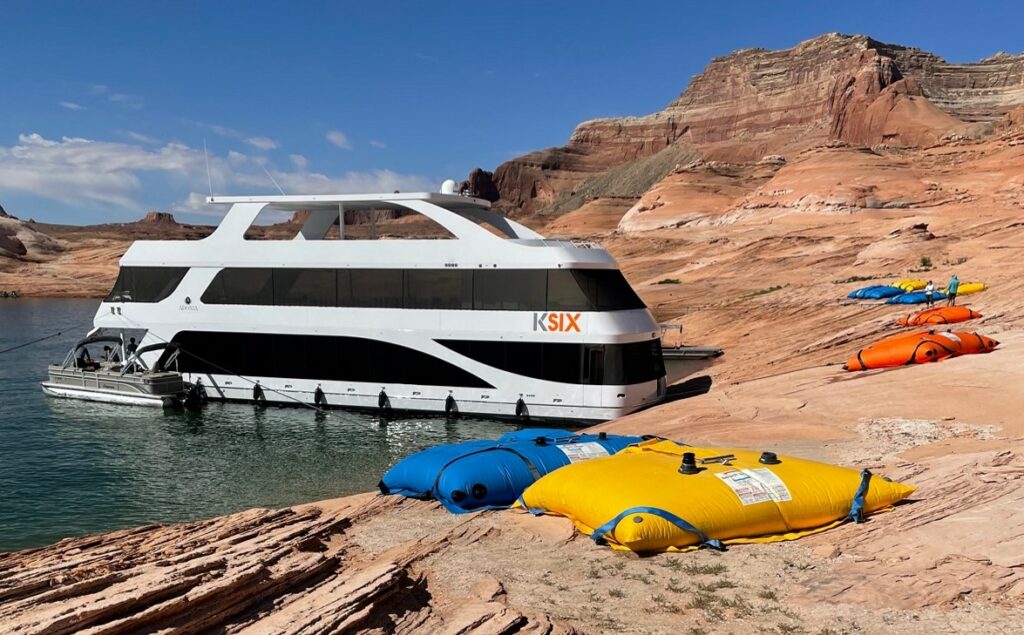
Anchoring. For many it’s the only difficult part of their houseboating vacation. But it doesn’t have to be. Just follow the steps below. And if you want to make it really easy, Antelope Point Marina has a great service for you. Just sit back, relax, and take advantage of our Full-Service Anchoring program with Beach Bags.
The key to establishing an effective houseboat beach anchorage, the kind that gives you the peace of mind to blissfully slumber the night away and to continue enjoying your vacation in the face of winds or impending storms, is understanding and implementing the 3 Elements of Houseboat Anchoring. They are:
- Selecting The Right Anchoring System
- Knowing the Anchor Placement Zones
- Maintaining Proper Anchor Line Tensions
Selecting the Right Anchor System
There are several houseboat anchor types, each having its pros and cons. The types available for legally anchoring on Lake Powell houseboats include the following:
- Fluke Anchors
Also know as a Danforth, these anchors are a lightweight plow style anchor used for mooring houseboats on deep sand beaches. Securing flukes to the shoreline involves digging multiple 2-3 foot deep holes (one for each anchor) and burying the anchors with the point down and toward the boat.

Pros:
-Highly effective, when properly seated and buried at the recommended depths.
Cons:
-Limits anchoring locations to sandy beaches.
-Requires a strong crew capable of digging several 2-3 feet deep holes.
-Can take as long as 1-1.5 hours to complete the anchoring process
- Natural Anchor Points
Objects such as a boulder are abundant on areas of Lake Powell and can serve as “anchors” to which houseboat lines can be tied.
Pros:
-A very fast and easy solution for anchoring. Just run your lines and tie them around the boulder.
Cons:
-Boulders might not be available, or in the right locations, when needed.
-The boulders may not be as strong as they appear and could fail during strong wind events.
- Beach Bags Anchor System
Beach Bags are an innovative houseboat anchoring solution available for houseboats hailing from Lake Powell’s Antelope Point Marina. Highly engineered and powerfully strong, they are comprised of a portable bladder system filled with water and an ingenious anchor line tightening system called Tightrope. Anchoring with Beach Bags is as easy as Fill & Chill.
Pros:
-More places to anchor your houseboat (easy to use on both rock and sand)
-Preserves shorelines (eliminates holes caused by digging, hammering, and drilling)
-Legal (approved for use on Lake Powell by the National Park Service)
-Improves houseboating safety by allowing you to easily keep anchor lines tight.
-Offered through a Full-Service Anchoring program.
Know where to Go – Beach Bags shows you the best locations on the Lake.
Effortless Anchoring – Beach Bags crews do all the anchoring work.
A Great Night’s Sleep – Relax, knowing you’re professionally anchored by Beach Bags.
More Privacy – More locations to escape the crowds and enjoy the Lake.

Cons:
-Anchoring Service limited to houseboats hailing from Page, AZ area marinas.
Knowing the Anchor Placement Zones
Houseboats come with multiple anchors. The number used will vary based on your houseboat’s size. Some of your anchors will be placed off the houseboat’s sides. These are called side Anchors. Others will be placed off your houseboat’s nose. These are call Bow Anchors. Place each anchor type in the following Anchor Placement Zones.
- Side Anchor Placement Zone:
Position in an area that is no great than 90 degrees and not less that 45 degrees in relation to the side of the houseboat on which they are located. (You’ll typically have one or two Side Anchors on each side of your boat)
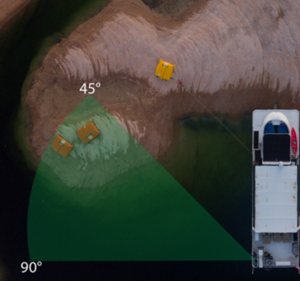
- Bow Anchor Placement Zone:
Position in an area that is no great than 45 degrees and not less than 15 degrees in relation to the side of the houseboat on which they are located. (You’ll typically have two Bow Anchors, one on each side of your boat)
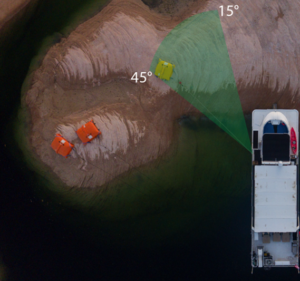
There are two simple methods for finding your Anchor Placement Zones:
- Side Anchor Placement Zone:
Using a smartphone app for finding angles, orient the phone so the length of the houseboat is the fixed side 0 degrees. Rotate the phone away from your houseboat until the angle measures no greater than 90 degrees, but not less than 45 degrees. Mark the shoreline location the smartphone is pointing to. This is the Zone where the Side Anchors should be placed. Follow the same process for the Bow Anchors, remembering that they should be placed in a Zone no greater than 45 degrees, but not less than 15 degrees.

- Walking Distance Method:
Walk a straight line perpendicular to the side of your houseboat. Stop only after traveling a distance that is greater than the length of the houseboat. This is the Zone in which the Side Anchors should be placed. (For example, if your houseboat is 70′ long, walk a distance of at least 70′). Deploying an anchor at a distance greater than the length of your houseboat will place it at an angle greater than 45 degrees. Use the same principle for placing your Bow Anchors.

Maintaining Proper Anchor Line Tension
The three most important things for maintaining a successful beach mooring, keeping your family safe, and enjoying your vacation are keeping your anchor lines tight, keeping your anchor lines tight, and keeping your anchor lines tight. This means having them tensioned to the point where there is no slack in the lines under normal conditions. This is true for all anchor types, whether they be flukes, natural anchor points, or Beach Bags.
Maintaining properly tensioned anchor lines helps keep the wind loads placed on your houseboat, and subsequently your anchor lines, static. Movement of your houseboat from a combination of strong winds and slack anchor lines allows dynamic forces to be placed on your anchors. These types of forces, when high enough, can cause your anchors to move and your mooring to fail.
It is very difficult to achieve a maintain proper tension by pulling on an anchor line and tying it off to a cleat – a anchoring practice common on houseboats 80′ and smaller. When line tightening aids such as Tightrope, can be used. It’s readily available to all houseboaters using Beach Bags Anchoring Services on Lake Powell.
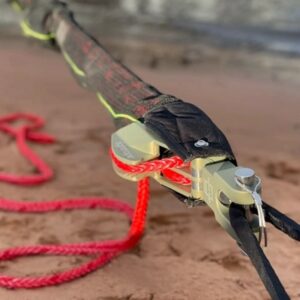
Enjoy the Adventure of a Lifetime
Thoughts of anchoring your houseboat can be worrying, but they don’t have to be. Come prepared, understand and implement the 3 Elements of Houseboat Anchoring, and relax, you’re on vacation!
Houseboat Safety Systems
Antelope Point Marina Houseboats
Your Antelope Point Marina Houseboat comes equipped with several safety systems and includes safety equipment for your use. When you take charge of your new watercraft, it is important to become familiar with the on-board systems and equipment, understand their proper use, and the location of all equipment on board your vessel. Your houseboat instructor will review each of these items and systems with you thoroughly allowing time for any questions you may have.
Some on-board safety systems are fully automatic. These include your carbon monoxide and smoke detectors, the bilge fire suppression system, and the gas fume/vapor detectors. Other safety equipment requires use by you and/or your crew. These include the fire extinguishers, and the personal flotation devices (PFD’s or more commonly known as life jackets) that are provided. If you are unfamiliar with any safety equipment on board, your houseboat instructor will make sure you are comfortable with its operation and use prior to your departure from the marina.
When you arrive at the marina for your houseboat orientation, a qualified and experienced Houseboat Instructor will review all safety equipment and systems with you. Most “Captains” find it helpful to assign one or two more “Mates” to take part in this important orientation.
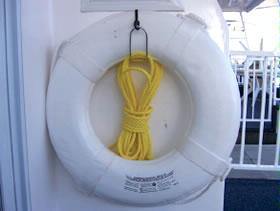
Houseboat Safety Equipment & Systems:
- Fire Extinguishers
- Marine Band Radio
- Global Positioning System (GPS)
- Throw Rings & Orange SOS Flag
- First Aid Kit
- 12v Electric Bilge Pumps
- Gasoline Fume Detector
- Automatic Engine Compartment Fire Supression System
- Anchors & Ropes (appropriate to your houseboat type)
Smoke Detectors
Your houseboat will be equipped with multiple smoke detectors throughout. You will test and review the location of your smoke detectors during your houseboat tour prior to departure from the marina.
Carbon Monoxide (CO) Detectors
Smoke detectors are installed in all cabins, hallways, and living areas of your houseboat. Detectors are extremely sensitive to even minimal levels of CO and will beep and flash to alert you to the presence of CO so that you can take the appropriate action.
CO Detectors play an important role in houseboating safety: Carbon monoxide is colorless, odorless, tasteless, and mixes evenly with air. It enters your blood stream through the lungs and displaces the oxygen that your body needs. Early symptoms of carbon monoxide poisoning include: irritated eyes, headache, nausea, weakness, and dizziness. These symptoms are often confused with seasickness or too much sun. Prolonged exposure can lead to serious illness or death so it is important to know when to take action.
Carbon monoxide can collect inside of any type of boat in a variety of ways. Poorly vented exhaust can re-enter a boat if it is moored too close to another boat, or if the exhaust is pushed back by prevailing winds. Exhaust can also re-enter through open windows and collect in still areas.
On your houseboat, carbon monoxide from your generator(s) is vented upwards through the “stacks” on the top deck to prevent a build-up around the back deck area. However, there is still a possibility that carbon monoxide could stay near the boat, particularly in very calm weather conditions, and become a hazard.
Marine Band Radio
A marine band radio is included on all houseboats and most power boats. Your marine band radio is your primary source of communication with marina facilities and services while on the lake. All marinas and the local authorities (NPS, Coast Guard or US Forest Service) monitor Channel 16.
When communicating on the radio, general protocol requires that you establish contact on Channel 16 and then switch to a mutually agreed upon channel for further communication. If your communication is an emergency, then you will stay on Channel 16. Your radio may also have a “WX” button which will give you weather information from the National Weather Service. Switch to channel “WX 1” to check updated weather conditions.
If you’re new to marine radio use, it can seem a little intimidating in the beginning. Your Houseboat Instructor will demonstrate how to use your radio as part of your check out procedure. Go ahead and try out the radio – you will soon be comfortable with the proper use of this very helpful and important tool for lake-wide communication.
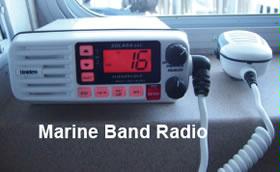
Automatic Engine Compartment Fire Suppression System
Your houseboat is equipped with an automatically activated Temperature Sensor Valve on a specially designed fire extinguisher installed in the engine compartment(s). This valve is designed to discharge when the sensor reaches a certain activation point. The suppression system is monitored at the helm and a green indicator light illuminates while underway to indicate the system is active. Your Houseboat Instructor will review this system with you during check-out.
Anchors and Ropes
Houseboats are required to be beached and properly anchored or staked by nightfall on all lakes. Your houseboat is equipped with ample anchors and high-quality marine ropes – able to secure even the largest vessel when properly deployed.
For a more complete review of how to anchor your houseboat, read the Anchoring or Staking Your Houseboat topic in the Houseboating 101 series.

Houseboat On-Board Water Systems
Your Forever Houseboat comes equipped with several water management systems, all designed to help make sure you have enough clean water throughout the duration of your trip. These systems are convenient and easy to understand and provide a visual display of how much water is available for use. Your houseboat instructor will explain the functions and limitations of this system prior to departure, and will answer any questions you or your crew may have.
When you arrive at the marina for your houseboat orientation, a qualified and experienced Houseboat Instructor will review the water systems with you. Most “Captains” find it helpful to assign one or two ” First Mates” to take part in this important orientation to make sure everyone else on board is briefed on water use and conservation.
Fresh Water
The fresh water tank on your boat provides all of the clean, filtered water for the sinks, showers, dishwasher, and ice makers. (The capacity of this tank will vary depending on your houseboat type.) There is a water gage on the helm to check your supply levels. If you are running low, you will need to head to the marina for a fill-up, however, careful water use by your whole crew should help avoid running out before you return.
The tank has its own filter and the pressure & flow is controlled by two fresh water pumps. You can control the water pressure with a switch on the 12-volt panel at the helm for the water pumps. The switch has three positions; The center position is “OFF”. Use this position when no water is needed. You can turn the pumps on by switching either direction. If one fails, switch to the other. There is limited water pressure so don’t try to use too many faucets at once.
Houseboat Tip: The hot water heater runs on generator power. It is important to make sure the generator is switched on BEFORE you step into the shower.
Waste Water
All of the sinks, showers, and toilets on your boat drain into a common waste holding tank (The capacity of this tank will vary depending on your houseboat type). None of your wastewater goes into the lake. This tank is emptied back at the marina when you return your houseboat. Conservation is very important to avoid filling up your tanks too quickly. A gage at the helm will show tank capacity and “Tank Full” warning lights will alert you to the need to have your tank pumped out sooner.

Marine Toilets
It looks similar to a normal toilet, but you will find that there are some big differences in how a marine toilet works compared to the one you use at home. The marine toilet on your houseboat draws water from the lake for flushing, and the water is discharged into the same tanks that all of the sinks and showers drain into. This way nothing goes into the lake. The whirring sound you hear when flushing is the in-line macerator grinding up the waste on its way to the holding tank.
Simple steps to help conserve your fresh water supply and make it last for the whole trip:
- Don’t leave the water running when you are washing, brushing your teeth, or shaving.
- When showering, turn the water off while lathering up.
- Use the dishwasher with a full load as opposed to washing dishes in the sink.
- Make sure your whole crew is “on-board,” and knows what to do.
*Conservation is also very important to avoid filling up your waste holding tank too quickly.
The Wet Slide
Many houseboat models come equipped with a water slide. When you push the button on the top of the slide a pump draws water from the lake and gets it wet for that perfect slide into the lake! The water will stop flowing when you release the button.
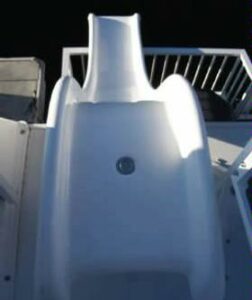
Houseboating Checklist:
Whether you’re planning your houseboat trip or are just lucky enough to just be a guest, here are some great tips on what to bring with you on the boat and what to leave at home so you can pack for success. Your packing list will vary depending on which lake you visit as well as which season you visit, but below are some tips that will allow you to get the most out of your trip to the lake.

Pack it in. Pack it out.
It is important to remember that what you’ll be packing to bring on to the boat, you’ll have to repack once your trip is finished, so try not to bring too much! Forever Resorts offers porters and/or wheeled carts to load and unload your belongings, but packing light will have it’s merits when it’s time to head home.
Paper or Plastic?
When packing your food and drinks, it’s a good idea to consider minimal packaging whenever possible. The less waste you generate, the less you’ll need to deal with after your trip. Every marina offers recycling stations, so be sure to take advantage of them. It is a good idea to avoid glass containers, particularly in items that will be discarded. Try to select compact and non-breakable packaging for your houseboat trip.
Frozen Goods
A trick that some houseboaters use to extend the life of their frozen food and ice supply is using ice-chests with a combination of regular and dry-ice. If you’re planning on packing frozen items that are to be used a few days into your trip, you can keep them at temperature longer by utilizing both dry ice and regular ice in a tightly sealed ice-chest. This trick will allow your frozen goods to be ready to thaw later in your vacation. An added advantage of this is the room it will save in the on-board refrigerator for other more commonly used items.
Houseboat Gear: Top 10 Items
- Sunscreen / Tanning Oil – you’re going to need plenty of it, even during the cooler and more cloudy days. Waterproof sunscreen is also highly suggested.
- Beach Towels – one for every few days that you are on the lake.
- Digital Camera or Camcorder – a vacation this great needs proof. Don’t forget to bring the charger.
- Favorite Spices – everyone has their favorite grilling and cooking recipes. Bring your favorite spices from home, the houseboat includes salt and pepper.
- Ice – see our Frozen Goods section above for more info on this. Ice is available for purchase at the top and bottom gift shops and also at our fuel dock.
- Hiking Boots or Shoes – there’s so much to discover along the shores at every lake, so be sure to bring appropriate footwear.
- Ski Vests – bring your own personal ski vest or purchase a ski vest at the Marina Store.
- Water – you’re going to get thirsty with all the fun you’ll be having!
- Music Player – all of our houseboats come equipped with music-player connections. Keep the good times rolling with your favorite tunes.
- First Aid Kit – all of our houseboats come equipped with first aid kits, but you know your guests best! Make sure to pack whatever you think you may need in case of an emergency.
Safe Boating Information
You might need a Boating License!
Depending on which state you live in, you might need a boating safety card before you head out onto the water. Various states have different laws and parameters regarding this. If you’re unsure, click the link below to check your state’s regulations.
Not certified yet?
If you have not completed a safe boating course yet, its not too late. You can either complete an in-person or on-line course from your state of residence (see links below), or you have the option to complete a classroom course from the United States Coast Guard Auxiliary or United States Power Squadron.

Don't forget your crew!
Many captains also find it handy to have their crew review a safety course before their voyage. These courses are a great way to get everyone to start thinking about the trip in advance and you will find that they make for safer boating as well. Many of the online courses are free to review, easy to read, include interesting illustrations and videos, and even offer practice tests free of charge.
State Resources:
- Sunscreen / Tanning Oil – you’re going to need plenty of it, even during the cooler and more cloudy days. Waterproof sunscreen is also highly suggested.
- Beach Towels – one for every few days that you are on the lake.
- Digital Camera or Camcorder – a vacation this great needs proof. Don’t forget to bring the charger.
- Favorite Spices – everyone has their favorite grilling and cooking recipes. Bring your favorite spices from home, the houseboat includes salt and pepper.
- Ice – see our Frozen Goods section above for more info on this. Ice is available for purchase at the top and bottom gift shops and also at our fuel dock.
- Hiking Boots or Shoes – there’s so much to discover along the shores at every lake, so be sure to bring appropriate footwear.
- Ski Vests – bring your own personal ski vest or purchase a ski vest at the Marina Store.
- Water – you’re going to get thirsty with all the fun you’ll be having!
- Music Player – all of our houseboats come equipped with music-player connections. Keep the good times rolling with your favorite tunes.
- First Aid Kit – all of our houseboats come equipped with first aid kits, but you know your guests best! Make sure to pack whatever you think you may need in case of an emergency.


